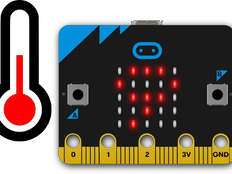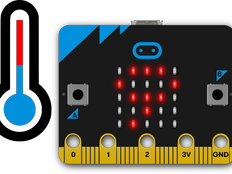Step 1: Make it
What is it?
Use two micro:bits so you can monitor outdoor temperatures remotely.
Introduction
Coding guide
How it works
- This project uses two different programs, one for the outdoor micro:bit which senses the temperature and transmits it on radio group 23.
- The outdoor micro:bit uses its temperature sensor to measure how hot or cold it is.
- It uses radio to send this temperature reading to the indoor micro:bit.
- When the indoor micro:bit receives a temperature reading from outside, it stores it in a variable called outdoorTemp.
- When you press input button A on the indoor micro:bit, it shows its own current temperature reading on its LED display output.
- When you press button B, it shows the temperature reading from outside that it has stored in the outdoorTemp variable.
What you need
- Two micro:bits
- MakeCode or Python editor
- battery pack
- A waterproof container, such a plastic box
Step 2: Code it
Outdoor sensor and transmitter:
Indoor sensor and receiver:
1from microbit import *
2import radio
3radio.config(group=23)
4radio.on()
5outdoorTemp = '-'
6
7while True:
8 message = radio.receive()
9 if message:
10 outdoorTemp = message
11 if button_a.was_pressed():
12 display.scroll(str(temperature()))
13 if button_b.was_pressed():
14 display.scroll(outdoorTemp)
15 Step 3: Improve it
- Make the batteries last longer by having the outdoor micro:bit turn its radio off when it’s not in use and sending temperature readings less often.
- Use variables to track the highest and lowest temperatures recorded.
- Calibrate the readings against another thermometer to see if you need to adjust the micro:bit’s temperature.
This content is published under a Creative Commons Attribution-ShareAlike 4.0 International (CC BY-SA 4.0) licence.


